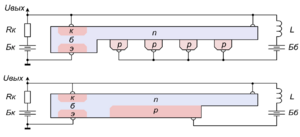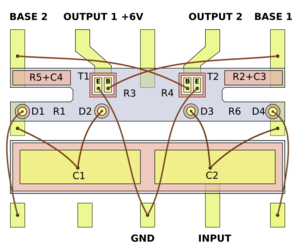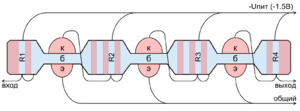Invention of the integrated circuit facts for kids
The first tiny integrated circuit (IC) chip was shown in 1960. Imagine a whole electronic circuit, with many parts, all shrunk down onto one small piece of material! This amazing idea started when a German scientist named Werner Jacobi patented an integrated transistor amplifier in 1949. Then, in 1952, a British engineer named Geoffrey Dummer suggested putting many electronic parts together on a single semiconductor crystal.
These early ideas were hard to make real until a big breakthrough happened in late 1958. Three clever people from different companies in the U.S. solved the main problems that were stopping integrated circuits from being made. Jack Kilby from Texas Instruments came up with the idea of putting everything together and made the first working prototypes. His invention was a "hybrid" IC, meaning some parts were still connected by tiny wires.
The first "monolithic" IC chip, where all parts and connections were made on one single piece of material, was invented by Robert Noyce of Fairchild Semiconductor. He found a way to connect the IC parts using aluminum and improved the way parts were kept separate using a special "planar process" developed by Jean Hoerni. On September 27, 1960, a team led by Jay Last at Fairchild Semiconductor used Noyce's and Hoerni's ideas to create the first working monolithic semiconductor IC.
There's been a lot of discussion about who truly invented the IC. In the 1960s, four people were often mentioned: Kilby, Lehovec, Noyce, and Hoerni. Later, the list often shortened to just Kilby and Noyce. Kilby won the Nobel Prize in Physics in 2000 for his part in the invention. Today's IC chips are mostly based on Noyce's monolithic IC design, which was a big step forward from Kilby's hybrid IC.
Contents
The Big Idea: How Tiny Chips Came to Be
Why We Needed Smaller Electronics

During and after World War II, a problem called "the tyranny of numbers" became clear. This meant that electronic devices, like early computers, had so many parts that they often broke down. For example, the ENIAC computer from 1946 had over 17,000 vacuum tubes! Each extra part made the device less reliable and took a long time to fix. Electronics needed a new way to be built, with fewer separate parts.
The invention of the first transistor in 1947 brought a lot of excitement. Transistors were much smaller and used less power than vacuum tubes. People hoped for a new age of "smart machines." But even with transistors, complex devices still had many connections between parts, which could fail. So, while the parts themselves got better, connecting them all was still a big challenge.
Early Thoughts on Integrated Circuits
The idea of putting circuits together started early. In 1949, a German engineer named Werner Jacobi patented a device that had five transistors on one piece of semiconductor. He thought it could be used for small, cheap hearing aids.
Then, in 1952, British engineer Geoffrey Dummer gave a speech where he talked about making electronic equipment as a "solid block with no connecting wires." He imagined layers of different materials, with electrical parts connected by cutting out areas. Dummer is known as "the prophet of integrated circuits."
In 1953, Harwick Johnson also filed a patent for making different electronic parts – like transistors, resistors, and capacitors – on a single chip. He described how to make a small oscillator (a circuit that produces a repeating electronic signal) on one piece of semiconductor. He didn't build a working device, but his ideas were important.
Later, in 1957, Yasuo Tarui in Japan made a special transistor that combined two types on the same chip. These early designs had several transistors sharing space, but they didn't have a good way to keep them electrically separate from each other.
The Rise of Silicon Technology
Early transistors were made from germanium. But by the mid-1950s, silicon became popular because it could work at higher temperatures. In 1954, Gordon Kidd Teal from Texas Instruments made the first silicon transistor.
A key discovery happened in 1958. Scientists Carl Frosch and Lincoln Derick found that layers of silicon dioxide (a type of glass) could protect silicon surfaces during manufacturing. This was a huge deal because, unlike germanium, silicon oxide is strong, doesn't react much with chemicals, and is a great electrical insulator.
Protecting the Surface: Surface Passivation
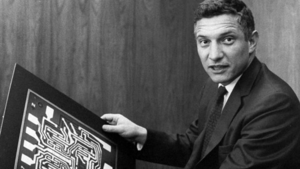
Protecting the surface of a semiconductor is called surface passivation. This makes sure the semiconductor's properties don't change when it touches air or other materials. Mohamed Atalla at Bell Labs first developed this in 1957. He found that growing a layer of silicon dioxide on silicon greatly reduced problems with electricity on the surface. This allowed electricity to reliably flow through the silicon.
Atalla showed his findings in 1958. By the mid-1960s, his method of using oxidized silicon surfaces was used to make almost all integrated circuits and silicon devices.
The Planar Process
Jean Hoerni was at the same meeting where Atalla presented his work. Hoerni realized that if silicon dioxide could protect the silicon surface, he could make transistors that were covered by this protective layer. This idea led to the "planar process."
In March 1959, Hoerni made the first planar transistor prototype. On May 1, 1959, he filed a patent for his invention. The planar process was a big step because it made transistors much more reliable. By the mid-1960s, it became the main way to produce transistors and monolithic integrated circuits.
Solving the Puzzle: The Three Big Problems
In 1958, there were three main problems holding back the creation of integrated circuits:
- Integration: How to make many different electronic parts on one single piece of semiconductor.
- Isolation: How to keep these parts electrically separate from each other on the same piece of material.
- Connection: How to easily connect all the parts on the chip without using expensive, tiny gold wires for every single connection.
It turned out that three different companies had key solutions to these problems.
Putting Parts Together: Kilby's First Chip
Kilby's Hybrid IC
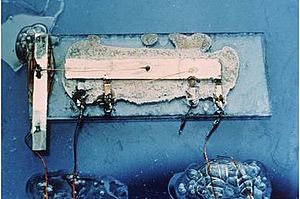
In May 1958, Jack Kilby started working at Texas Instruments. He was looking for a way to make electronics much smaller. He realized that a semiconductor company should focus on semiconductors. He also thought that all circuit parts, like resistors and capacitors, could be made from semiconductor material. And, importantly, all these parts could be formed on one piece of semiconductor, with only the connections added.
On August 28, 1958, Kilby put together a first test IC using separate parts. Then, on September 12, he showed the first actual IC prototype. It was a simple oscillator circuit. A week later, he made a second prototype, a two-transistor "trigger" circuit.
Kilby's inventions were a big step. However, his ICs were "hybrid" because the parts were separated by cutting grooves, and they still needed tiny gold wires for connections. He showed that many different circuit elements could be made on one chip.
Selling the First ICs
In late 1958, Texas Instruments showed Kilby's idea to military customers. The U.S. Air Force was interested and ordered prototype ICs, which Kilby called "functional electronic blocks."
In April 1960, Texas Instruments announced their multivibrator #502 as the world's first integrated circuit for sale. It had two transistors, four diodes, six resistors, and two capacitors. It was made of two small silicon strips inside a metal case, with gold wires connecting them.
In 1961, Texas Instruments built a "molecular computer" for the Air Force. It used 587 ICs to replace about 8,500 transistors and other parts! This showed how much space ICs could save.
Keeping Parts Separate: Isolation by p-n Junction
Kurt Lehovec's Solution
In late 1958, Kurt Lehovec, a scientist at Sprague Electric Company, found a simple way to solve the isolation problem. He realized that a "p-n junction" (a boundary between two types of semiconductor material) acts like a wall, stopping electric current. So, by putting enough p-n junctions between parts, he could keep them electrically separate.
Lehovec tested his idea. His device was a small, thin strip of material divided into isolated sections by p-n junctions. He made all the connections by hand using gold wires.
Sprague's management wasn't very interested in Lehovec's invention. He filed a patent application on his own in April 1959.
Robert Noyce's Solution
On January 14, 1959, Jean Hoerni showed his latest planar process to Robert Noyce at Fairchild Semiconductor. This process was key to Noyce's ideas.
On January 23, 1959, Noyce wrote down his vision for a planar integrated circuit. He basically re-invented some of Kilby's and Lehovec's ideas, but he used Hoerni's planar process as the foundation. Noyce's approach created flat, two-dimensional structures, allowing for many devices on one chip.
Noyce's patent application was initially rejected because Lehovec had already filed a similar one. Noyce revised his application and eventually received patents in 1964.
Connecting the Parts: Invention of Metallization
In early 1959, Noyce solved another big problem: how to connect all the parts on the IC. He realized that the protective oxide layer on the chip could also act as a barrier between the chip and the metal connections. He proposed depositing a metal layer (like aluminum) that would stick firmly to the oxide, connecting only where needed.
Noyce filed his patent application for this idea in July 1959. This method of using a metal layer on top of an insulating oxide layer is still a basic part of how modern ICs are made.
The First Monolithic Integrated Circuits
In August 1959, Noyce started a group at Fairchild to develop integrated circuits. On May 26, 1960, this group, led by Jay Last, made the first planar integrated circuit. This early version still had some parts isolated by cutting grooves.
But in August 1960, Last's team started working on a second prototype, using Noyce's idea of p-n junction isolation. They made a trigger circuit with four transistors and five resistors. The first working device was tested on September 27, 1960. This was the first true planar and monolithic integrated circuit!
Even though this was a huge invention, some at Fairchild didn't see its importance. In January 1961, some key people, including Last and Hoerni, left Fairchild to start other companies.
Despite these departures, Fairchild announced their first commercial IC series, "Micrologic," in March 1961. Other companies were also making ICs by then. Texas Instruments, for example, started making planar ICs for space satellites and missiles.
NASA's Apollo Program was a huge customer for integrated circuits between 1961 and 1965. The computers for the Apollo spacecraft used about 5,000 standard logic ICs each. During their production, the price of an IC dropped from $1,000 to just $20–30! This helped prepare the way for ICs to be used in everyday products.
Early ICs used a type of logic called "resistor-transistor logic" (RTL). This was sensitive to electrical interference. So, in 1964, Fairchild and Texas Instruments switched to "diode-transistor logic" (DTL), which was more robust.
TTL and MOS Integrated Circuits
In 1961, James L. Buie invented transistor–transistor logic (TTL). This became a very successful type of IC. By the 1970s and early 1980s, TTL was the most common IC technology.
Another major breakthrough was the MOSFET (metal-oxide-silicon field-effect transistor), invented by Mohamed Atalla and Dawon Kahng at Bell Labs in 1959. The MOSFET allowed for very dense integrated circuits, meaning many more parts could be packed onto one chip. Almost all modern ICs today are based on MOSFETs.
The first experimental MOS IC was a 16-transistor chip made by RCA in 1962. In 1964, General Microelectronics released the first commercial MOS IC, a 120-transistor shift register. The MOSFET became the most important part in modern ICs.
The Patent Wars (1962–1966)
In the early 1960s, Texas Instruments became very protective of its patents, earning nicknames like "The Dallas legal firm." Other companies followed suit, leading to many legal battles over who invented what. However, the IC industry kept growing despite these disputes. The U.S. Appeals Court eventually ruled that Noyce was the inventor of the monolithic integrated circuit chip, based on his use of adherent oxide and p-n junction isolation.
- Texas Instruments vs. Sprague: Kurt Lehovec received a patent for p-n junction isolation in 1962. Texas Instruments claimed their earlier Kilby patent covered this. After a long fight, Lehovec proved that Kilby's patent didn't mention isolation of components. Lehovec's priority for the isolation patent was finally recognized in April 1966.
- Texas Instruments vs. Fairchild: Texas Instruments focused on its biggest competitor, Fairchild Semiconductor. These lawsuits made it hard for Fairchild to sell licenses for its technologies. By 1965, Fairchild's planar technology was the industry standard, but few companies had licenses. In 1964, an arbitration awarded Texas Instruments rights to some key patents, but both companies appealed. After losing the dispute with Sprague in 1966, Texas Instruments realized they couldn't claim priority for all key IC patents. In the summer of 1966, Texas Instruments and Fairchild agreed to recognize each other's patents and share licenses. Sprague joined them in 1967.
- Japan vs. U.S. Companies: In the early 1960s, both Fairchild and Texas Instruments tried to set up IC production in Japan. However, the Japanese Ministry of International Trade and Industry (MITI) resisted. In 1962, MITI blocked Fairchild's investments. Texas Instruments faced similar resistance. In 1965, Texas Instruments threatened to block imports of Japanese electronics that used their patented technology. This led to secret negotiations, and in 1967–1968, a deal was made that was very favorable to Japan. For almost 30 years, Japanese companies made ICs without paying royalties to Texas Instruments. Only in 1989 did a Japanese court recognize Kilby's patent rights. As a result, in the 1990s, Japanese IC makers had to pay for the old patent or enter into licensing agreements.
Who Invented the IC?
During the patent wars, many people recognized that several inventors contributed to the IC. Books from the 1960s often named Kilby, Lehovec, Noyce, and Hoerni.
In 1966, Kilby and Noyce were given a special award for their important work on integrated circuits. This started the idea that there were "two inventors." Some people criticized this, saying Kilby's early prototypes weren't "real" semiconductor ICs. Noyce's nomination was also debated, as many knew the important roles of Hoerni and others. Noyce himself said, "I was trying to solve a production problem. I wasn't trying to make an integrated circuit."
Historians like Leslie Berlin suggest that Noyce became known as the "father of the integrated circuit" partly because of the patent wars. Texas Instruments chose his name for their legal challenges, making him the main representative for Fairchild's work. Fairchild then put all its efforts into defending Noyce's priority.
By the mid-1970s, the "two-inventor" story became widely accepted. Hoerni, Last, and Lehovec were seen as less important, partly because they didn't represent large companies and weren't as public about their claims.
In 2000, Jack Kilby received the Nobel Prize in Physics for his part in the invention of the integrated circuit. Robert Noyce had passed away in 1990 and couldn't be nominated.
More recently, in the late 1990s and 2000s, new books and research have brought back the idea that many people contributed to the IC. Historians like Leslie Berlin, Bo Lojek, and Arjun Saxena have highlighted the important work of Hoerni, Last, and Lehovec, showing that the invention of the integrated circuit was truly a team effort over many years.
Images for kids


